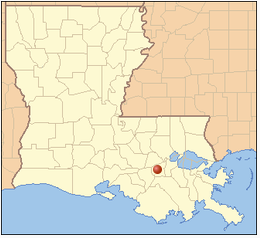| Home | Search | Emissions | Pollutants | About the Database |

Motiva Enterprises (2719), Convent
LDEQ Accident Report
| Accident # | 143446 |
| State Police # | 12-06550 |
| Accident Date | 2012-10-01 |
| Report Date | 2012-10-05 |
| Follow-up Date | 2012-11-15 |
| Follow-up: | Yes |
Pollutants Released
| Pollutant | Duration | Point Source | Greenhouse Gas | Criteria Pollutant | Ozone forming chemical | Amount of Release |
| NOx | 1h | Flare #2 | NO | NO | YES | 10.0 pounds |
| Crude Oil | 45m | VPS-2 supply line | NO | NO | NO | 3,099.6 gallons |
Accident Classified As: Reportable Quantity
Cause of Problem: Corrosion
The supply line for the VPS-2 atmospheric bottoms sample station was lined-up to the discharge of the atmospheric tower bottoms pump. The unit was in operation and the pump was online with a discharge pressure of approximately 145 PSIG. At approximately 4:00 am on October 1, 2012 the sample supply line was breached. The auto ignition temperature of this stream was approximately 500 deg F, and the operation temperature was 700 deg F. These conditions were enough to cause ignition and support the chemical reaction needed to sustain the fire. The piping where the fire began was inspected and a beach was found on top of the sample supply line. The breach consisted of a "flap" of metal which had separated from the pipe revealing a 1" by 1 3/4" opening. The A106B carbon steel piping of the sample line had been exposed to process material containing 4% sulfur, operating at 700 deg F, and had been so for a sufficiently long period creating sufficient conditions for the mechanism to occur. The change in metallurgy from the process line (9 Cr steel) to the sample station line (carbon steel) appears to have made the sample line piping more vulnerable to corrosion. Furthermore, a review of the incident revealed the root valves of the sample line were 12'-15' above grade and had to be accessed using a portable ladder. These valves were difficult to operate even when temporary access means were provided. A new sample schedule had been issued, requiring the sample to be taken twice a week, requiring even more access to the valves. The practice became to leave the valves open, thereby leaving the piping exposed to the corrosive environment. This ultimately accelerated the corrosion rate in the system.
Discharge Preventable - No
The release and subsequent fire was not preventable based on the information that was available to engineering and operation personnel at the time. The threat was not recognized when the change was made in the sampling frequency.
Notes/Remedial Actions
The crude oil released during the fire that was deposited on the unit slab and nearby equipment. In addition, small particles of entrained oil in the fire water mist migrated downwind and deposited outside the unit boundary on Motiva propery. These off-unit areas were cleaned, excavated and/or immobilized/degraded. There were no oil residues from the fire observed off site. Site perimeter air monitoring was conducted for %O2, LEL, H2S, CO and SO2. All readings were normal ranges or non-detectable. Motiva Operations immediately initiated an unplanned but controlled shutdown of VPS-2. Excess process gases associated with the shutdown were routed to the refinery's flare system for destruction. The sample station and piping where the breach occurred has been removed and a review is being conducted site-wide for other locations that may have a similar threat/issue. Sample station design standards are being expanded to incorporate a strategy for managing the metallurgy of sample stations with respect to the metallurgy of the process line. In the 7-day letter, Motiva initially estimated the amount of crude oil released to be 6.5 bbls; they have now determined that 73.8 bbls were actually released during this incident. An estimated 68.6 bbls were consumed by the fire, 1.2 bbls released to the unit slab, and 4 bbls were released in areas downwind of the unit slab, but on Motiva property. On the LDEQ verbal report, it is noted that NOx exceeded reportable quantity and went to flare #2; this is not mentioned in any of the follow-up reports submitted by Motiva following this incident.

Connect With Us: